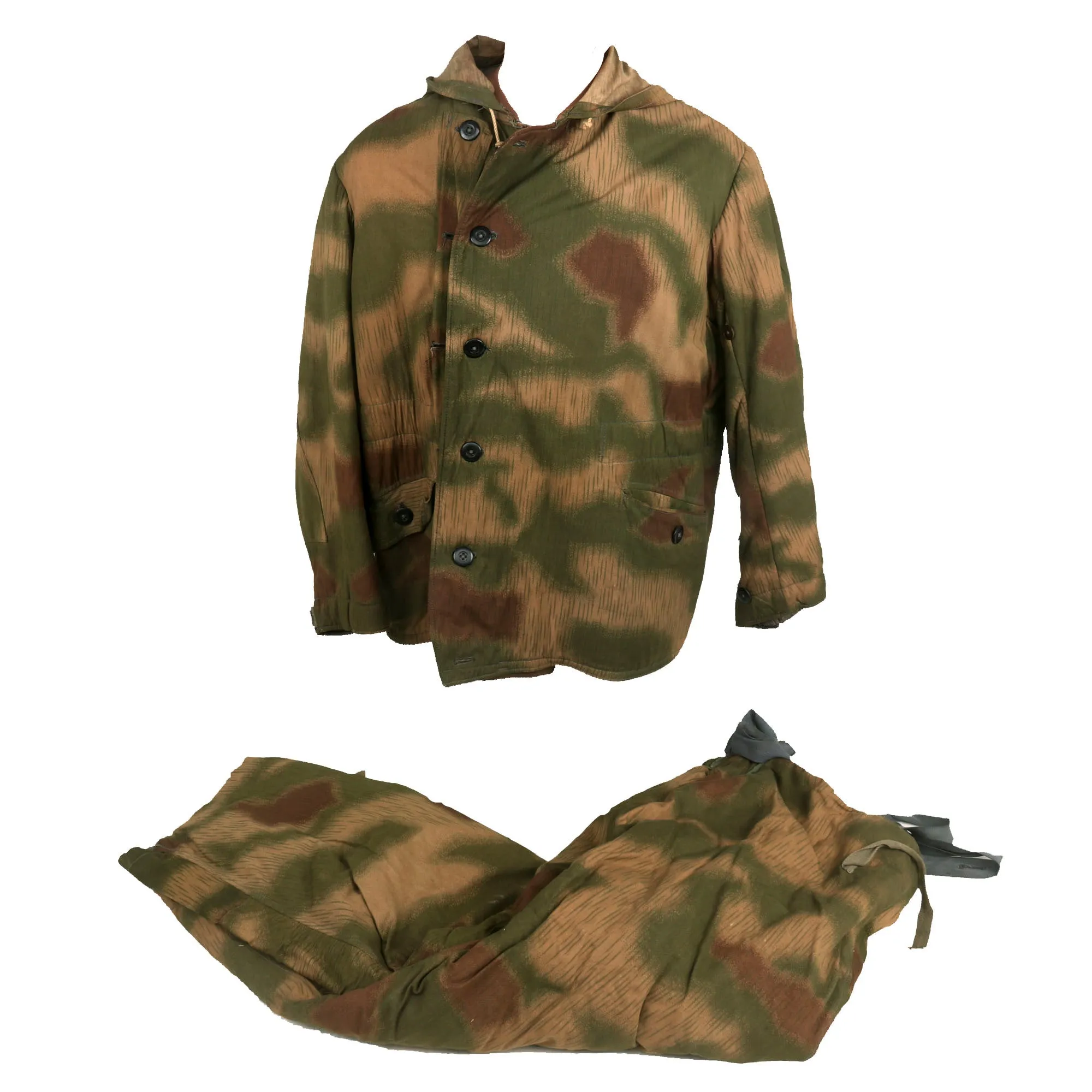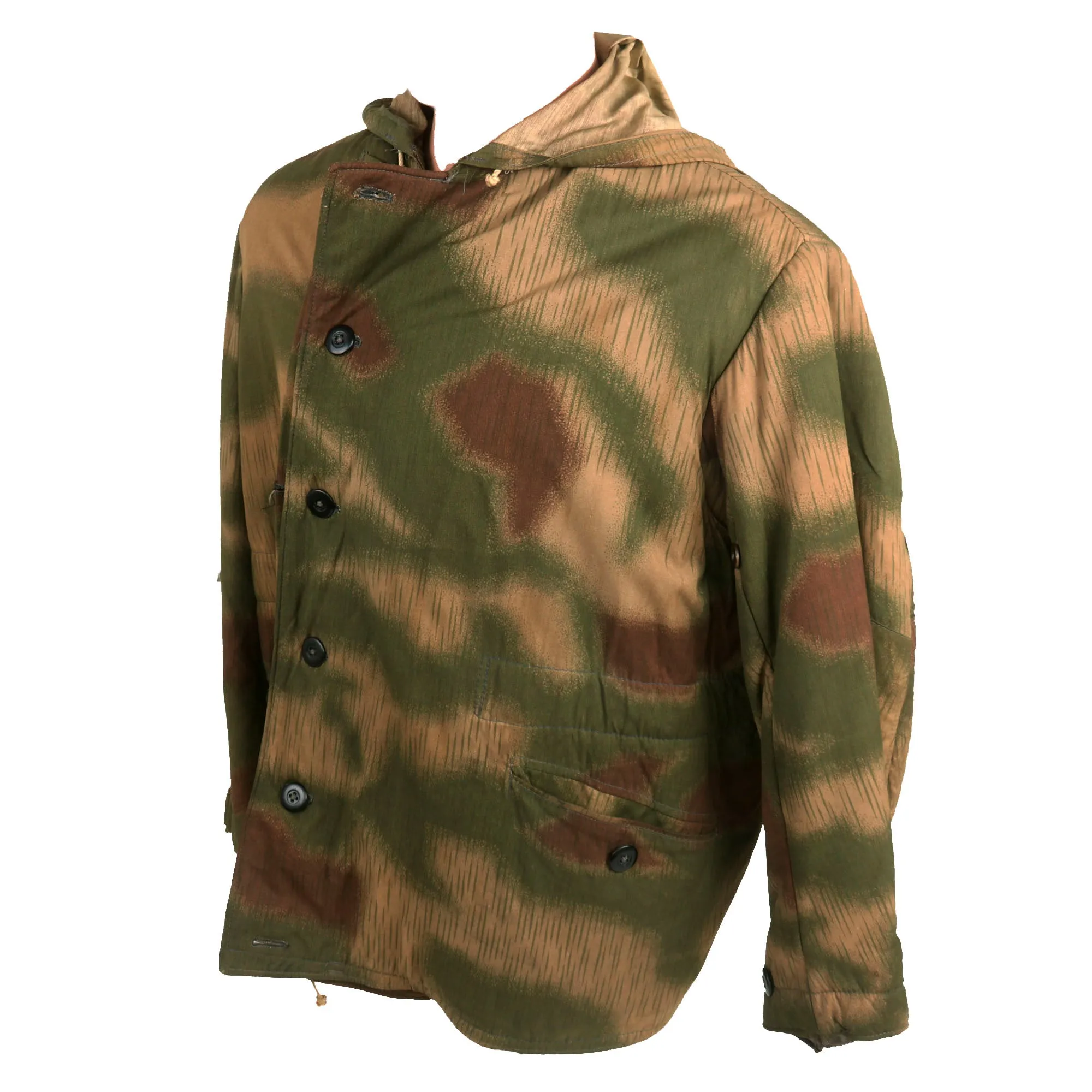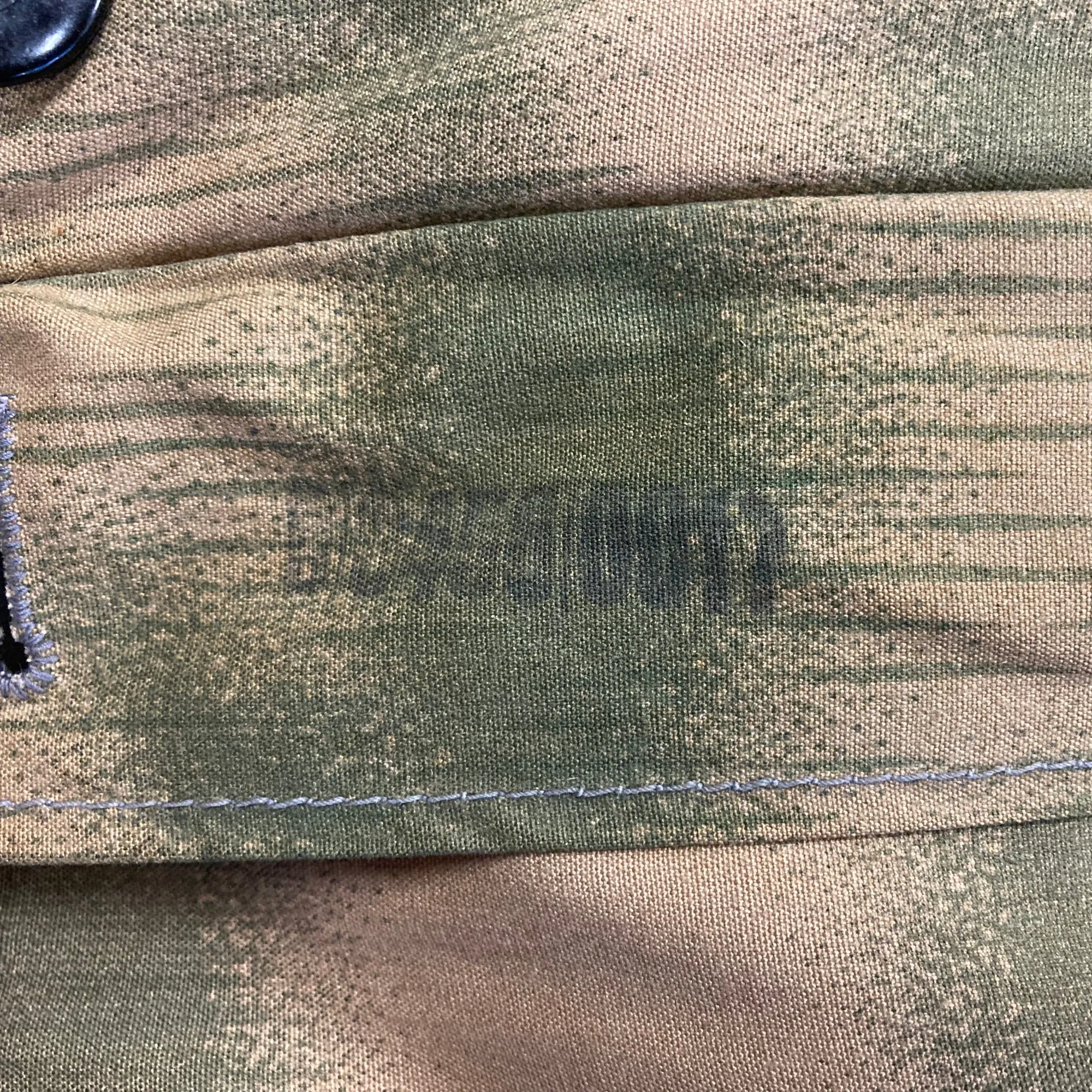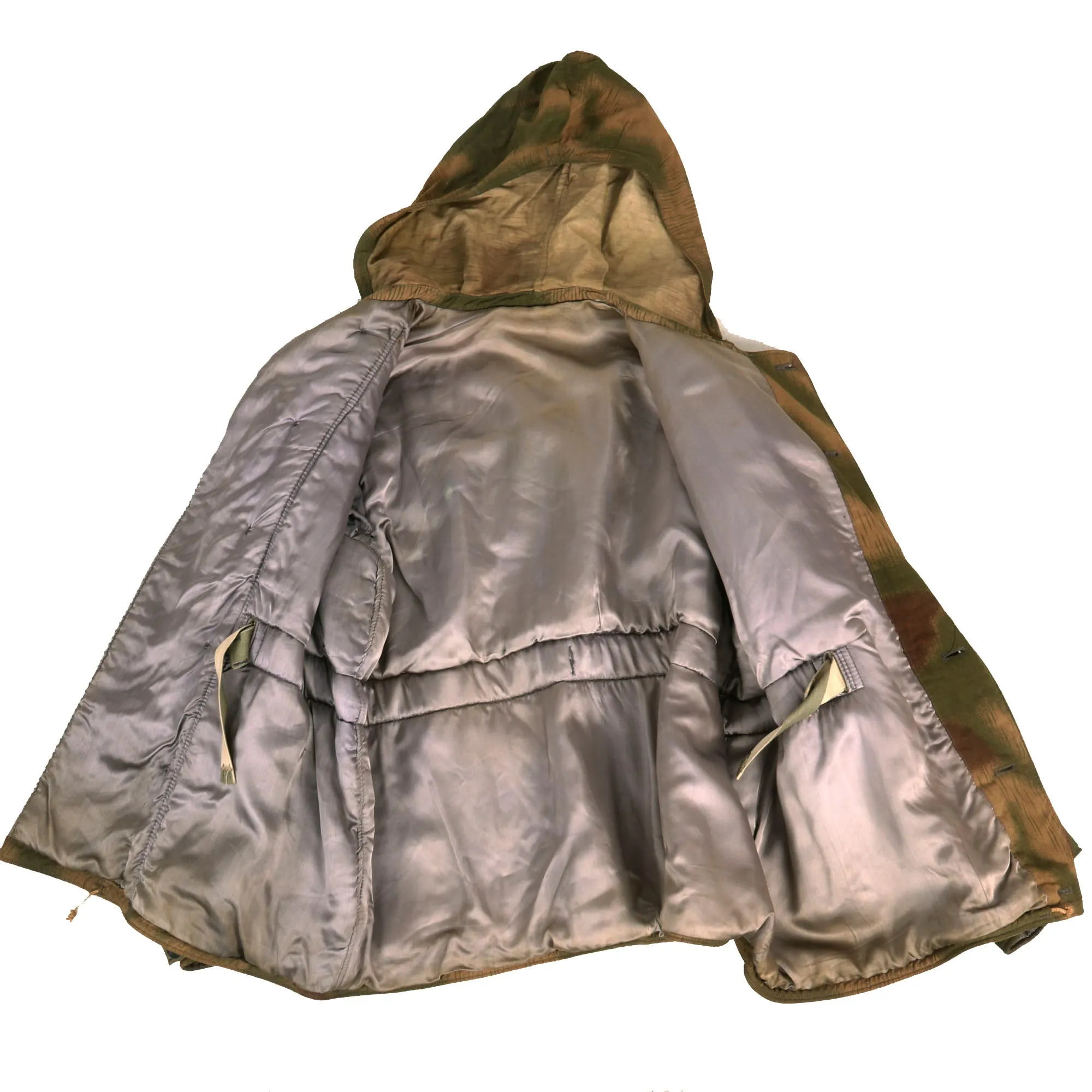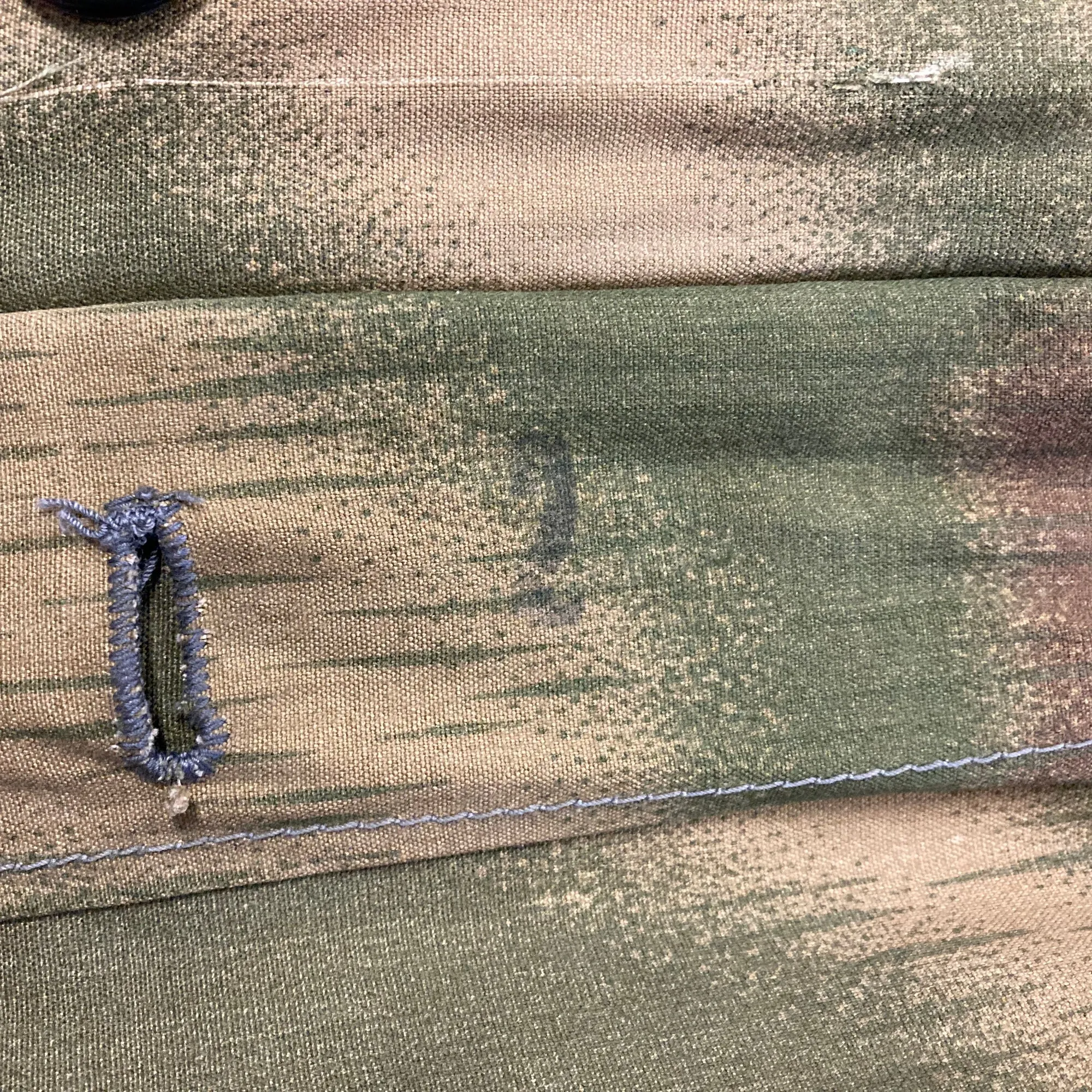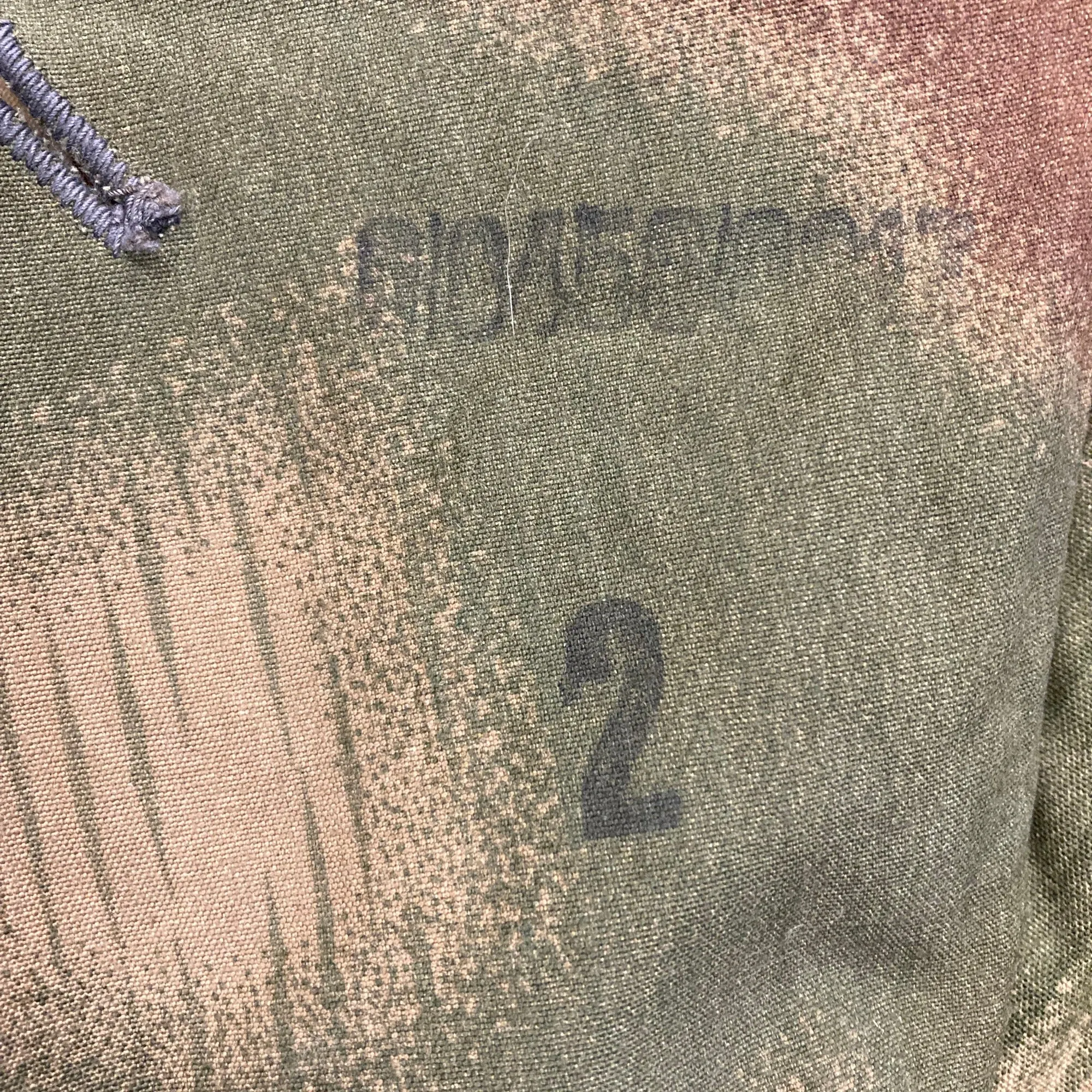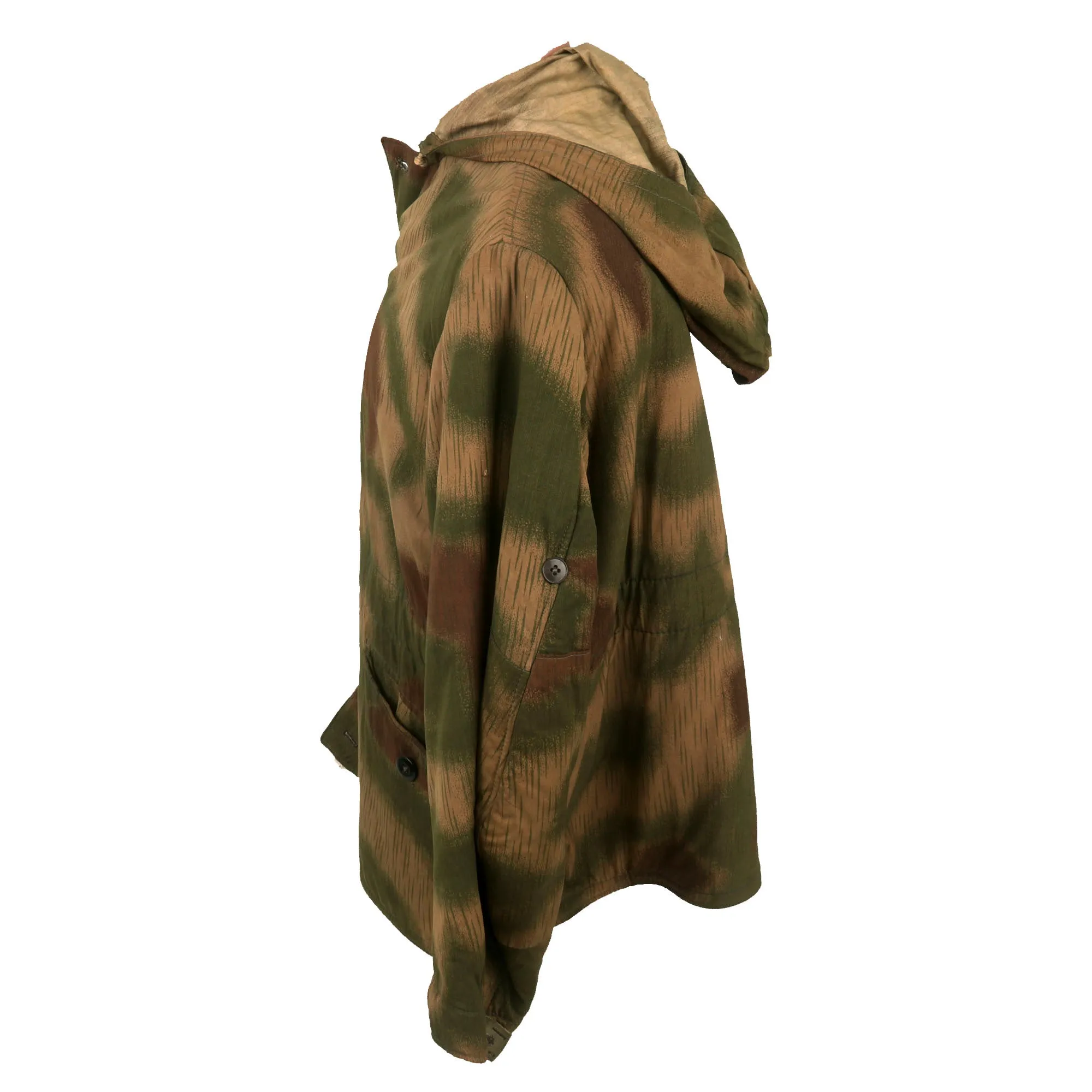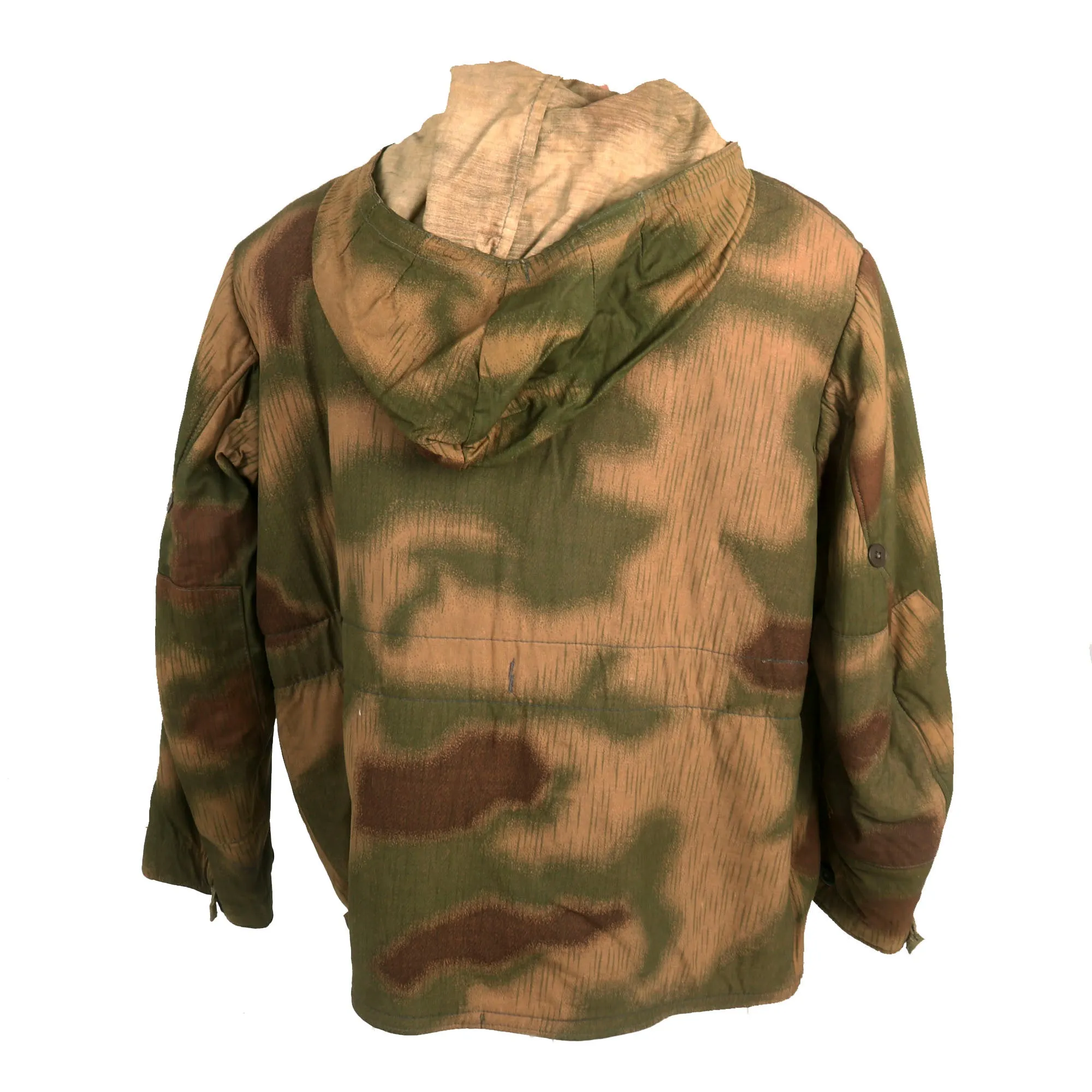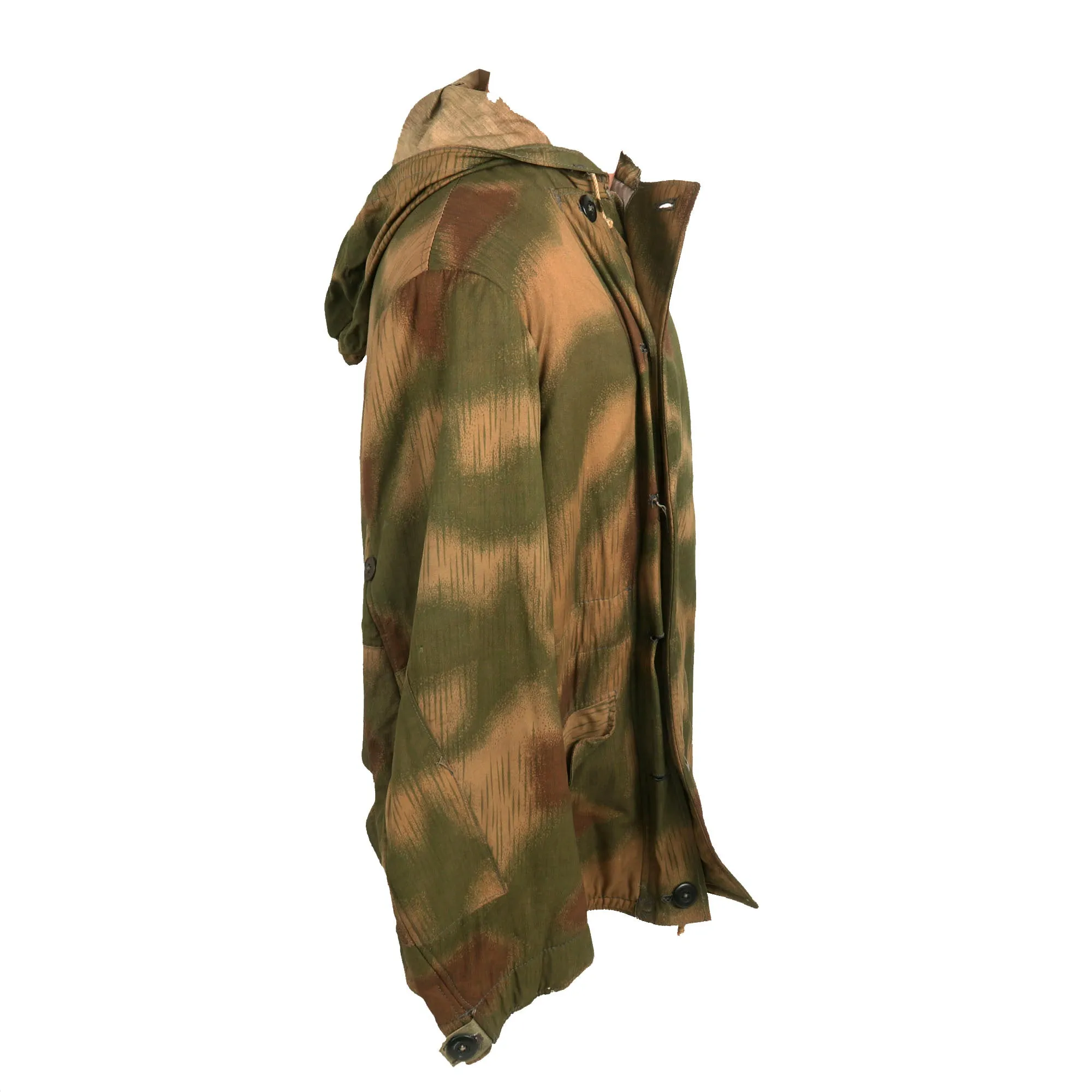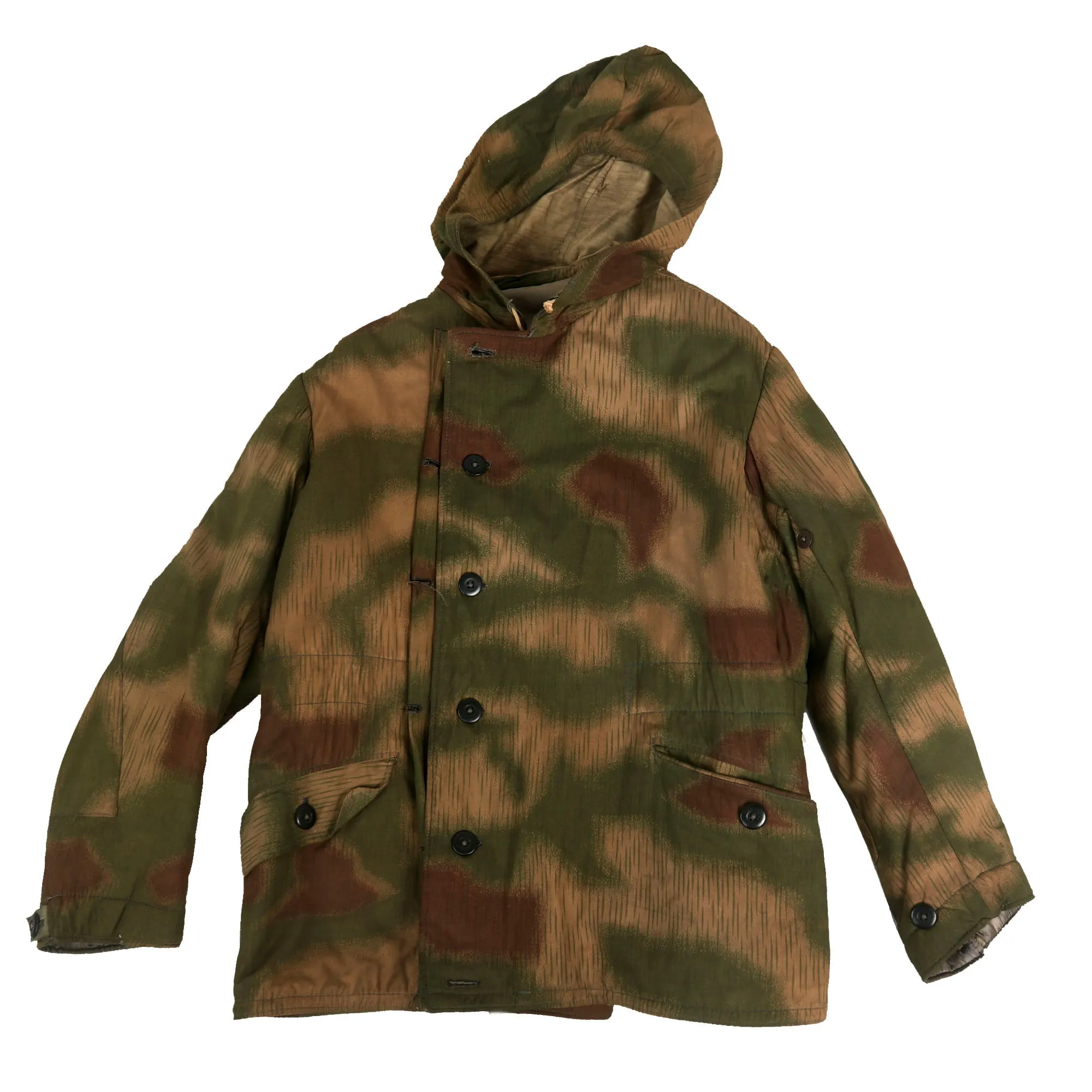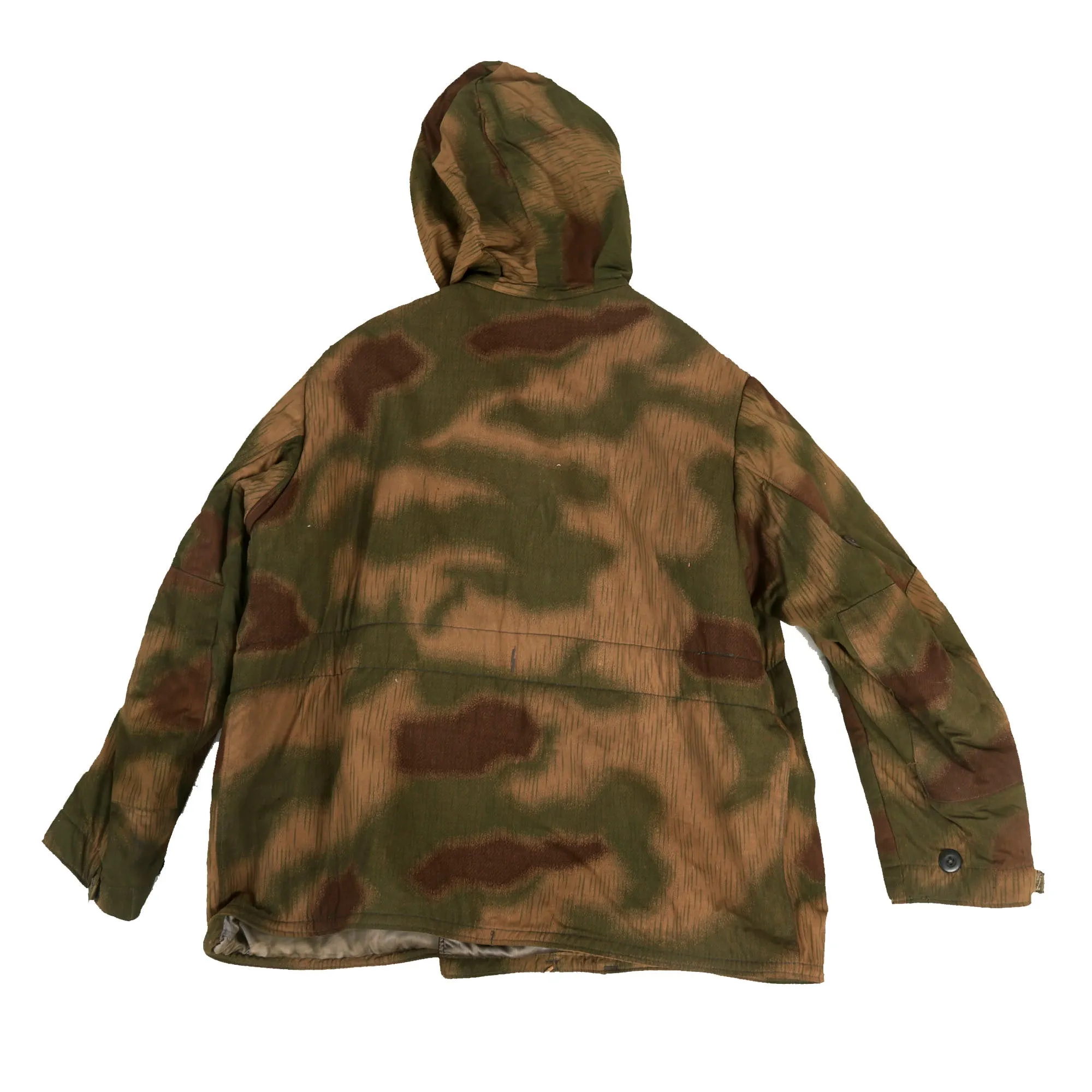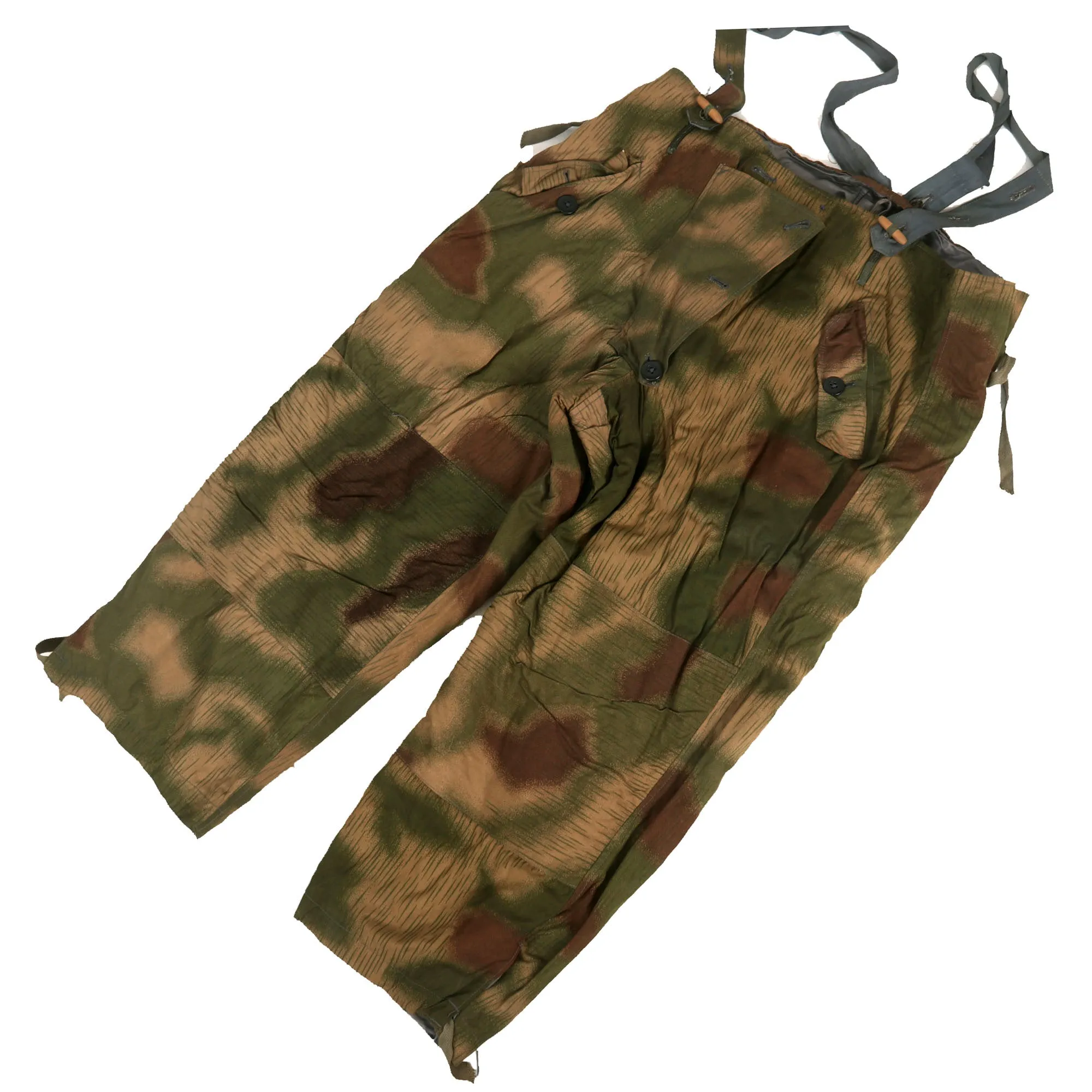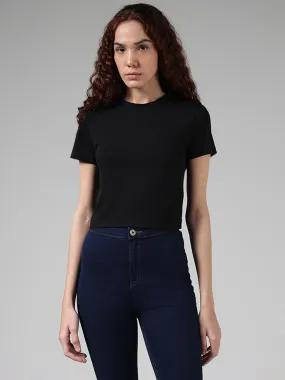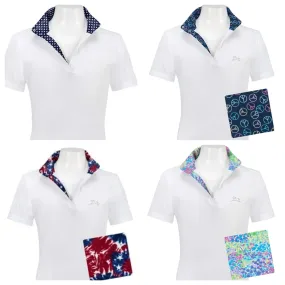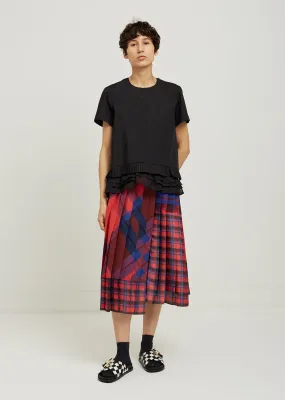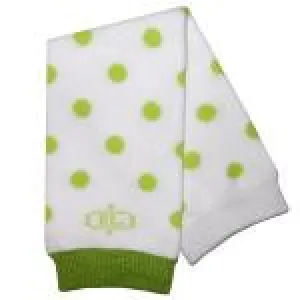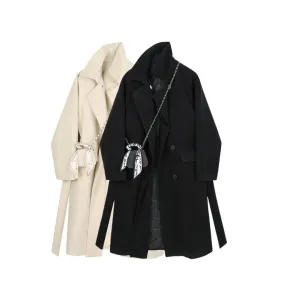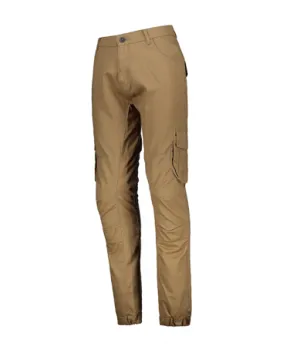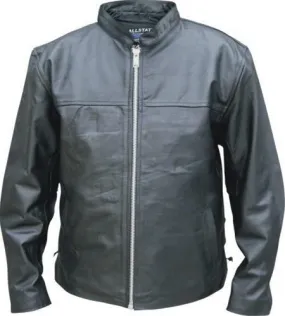Original Item: Only One Available: This is a wonderful condition Swamp Pattern Camouflage parka used by German soldiers during World War Two, complete with the very hard to find matching pants! The Sumpftarnmuster (Swamp or Tan Water Camouflage Pattern) model parkas appeared in the winter of 1943 and were widely issued throughout the German Army and some specialty units.
Many parkas reverse from camouflage to white, however this example does not and has a lovely gray rayon lining. Both the hood and waist drawstrings are present and fully functional. The six front closure buttons are all present, as are the two buttons at the end of each sleeve. They are all plastic or bakelite and are in very good condition, withy the stitching still strong. The camouflage exterior is in excellent condition, with strong coloring and very little fading. It does not show any major damage, and is still relatively stiff, indicating it did not see much use. This definitely is one of the best examples that we have seen. The interior shows some light wear and minor staining, but no major tears or other damage. There is no size stamp present or any other markings we can see. The internal belts for adjusting the fit look to be fully intact and functional.
The included pants are in very good condition, and match the parka completely in color and style. The exterior shows little to no wear, still feeling stiff from the camouflage print, and they are lined with the same blue rayon. The buttons for the front closure and slash pockets are all still present, and are the same plastic or bakelite buttons as on the parka, so the pants were probably made by the same maker. The pants come with their original blue gray web suspenders, which attach to wooden dowels on the pants, They even have sewn on camouflage on the ends so that if the ends are seen, it does not ruin the camouflage profile. The bottom of the pants have a drawstring closure. Condition is excellent overall, and we are unlikely to see a better set anytime soon.
We checked all over both the parka and pants, and finally found markings under the button flaps on the exterior. The parka and pants are both marked with RBNr. 0/0456/0017 and a size of 2, so this is a matched set in the same size by the same manufacturer!
A very rare and hard to find original World War II German winter parka and pants set, most likely the best set that we have had! This set would be VERY hard to improve upon! Comes more than ready for display, or even wear!
Approximate Measurements:
Collar to shoulder: 10.5"
Shoulder to sleeve: 22.5”
Shoulder to shoulder: 18”
Chest width: 24"
Waist width: 24"
Hip width: 24"
Front length: 26"
Pants:
Waist: 22"
Inseam: 24.5"
German World War II camouflage patterns formed a family of disruptively patterned military camouflage designs for clothing, used and in the main designed during the Second World War. The first pattern, Splittertarnmuster ("splinter camouflage pattern"), was designed in 1931 and was initially intended for Zeltbahn shelter halves. The clothing patterns developed from it combined a pattern of interlocking irregular green, brown, and buff polygons with vertical "rain" streaks. Later patterns, all said to have been designed for the Waffen-SS by Johann Georg Otto Schick, evolved into more leaf-like forms with rounded dots or irregular shapes. Camouflage smocks were designed to be reversible, providing camouflage for two seasons, whether summer and autumn, or summer and winter (snow). Distribution was limited to the Waffen-SS, ostensibly because of a patent, though variants were used by other units, including the Luftwaffe. Production was limited by shortage of materials, especially of high quality waterproof cotton duck.
The Reichswehr (Army of the Weimar Republic) started experimenting with camouflage patterns for Wehrmacht uniforms before World War II and some army units used Splittertarnmuster ("splinter camouflage pattern"), first issued in 1931, and based on Zeltbahn shelter halves/groundsheets. Waffen-SS combat units used various patterns from 1935 onwards. The SS camouflage patterns were designed by Johann Georg Otto Schick, a Munich art professor and then the director of the German camouflage research unit,[a] at the request of an SS Major, Wim Brandt. Brandt was an engineer and the commander of the SS-VT reconnaissance battalion, and he was looking for better camouflage. Schick had researched the effect of light on trees in summer and in autumn. These led to the idea of reversible camouflage clothing, with green summer patterns on one side, brown autumn patterns on the other. In 1937, the patterns were field tested by the SS-VT Deutschland regiment, resulting in an estimate that they would cut casualties by fifteen percent. In 1938, a reversible spring/autumn helmet cover, smock, and sniper's face mask in Schick's forest patterns on waterproof cotton duck were patented for the Waffen-SS. The patent is said to have prevented the Wehrmacht from using the patterns, which became a distinctive emblem of the Waffen-SS during the war. However, patterned uniforms were worn by some other units, including from 1941 the Luftwaffe, which had its own version of Splittertarnmuster, as well as the Kriegsmarine (navy), the Fallschirmjäger (paratroops), and the Waffen-SS. The 1945 Leibermuster was planned to be issued to both the SS and the Wehrmacht, but it appeared too late to be widely distributed.
Production of groundsheets, helmet covers and smocks by the Warei, Forster and Joring companies began in November 1938. They were initially hand-printed, limiting deliveries by January 1939 to only 8,400 groundsheets and 6,800 helmet covers and a small number of smocks. By June 1940, machine printing had taken over, and 33,000 smocks were made for the Waffen-SS. Supplies of high quality cotton duck, however, remained critically short throughout the war, and essentially ran out in January 1943. It was replaced by non-waterproof cotton drill cloth.
Reichsbetriebsnummer or RB number (also represented as RB Nr or Rbnr). Before the war, the Germans set up a system for registering and recording the factory information, the Reichsbetriebskartei. This was to help enable machine tabulation of facts and figures. It was from this that the Reichsbetriebsnummer came into being. The Reichsministerium für Rüstung und Kriegsproduktion (Ministry for Armaments and War Production) files survive today in the Bundesarchiv, however, these are only fragmentary. There is a holding file from the working group created by the Office of Machine Reporting in the Armament Office of the Reich Ministry for Armaments and War Production - their main focus was the operations of the industry group for which an economic interest was Armour production. This index provides information on the most important data of the companies covered by it, production profile, operating area, number of employees and the responsible operator.
As a prerequisite for the intended use of the punch-card method in the armaments industry, it was this system which gave rise to the Rbnr. The operating numbers were assigned by the competent local district offices of Machine reporting. (Bezirksstellen des Maschinellen Berichtswesens.) The index is in the form of index cards that are accessible numerically (approximately 14 meters of index cards!). Access to this register is only possible through the naming of this company, stating the place of production. The Reichsministerium für Rüstung und Kriegsproduktion files have multiple entries on the introduction of the factory and also the lot no.
The Rbnr code was used from 1943 onwards and replaced the makers name and address (or company logo) on government contract uniforms, caps and field equipment and knives. It is either rubber ink stamped on cloth or die stamped onto leather & metal items. It has been written countless times that this numeric code system was introduced as a security measure to help mask production locations. This was not the case but it was perhaps, a helpful by- product of the system. It is not unknown to find the Rbnr together with the maker’s info. Had it been a security measure, clearly this practise would have been banned.
So what was the Rbnr? It was a nine digit number and was normally represented thus: RB Nr: 0/000/0000.
The first prefix number could range from 0 through to 9. This number determined the membership of the various groups in the realm of Trade and Industry (Reichsgruppenleitzahl)
• 0 Industry
• 1 Crafts
• 2 Commercial wholesale trading companies
• 3 Banking
• 4 Insurance Companies
• 5 Energy (Electrical companies and such)
• 6 Tourism (Including Hotels, Wine and Mineral Water companies)
• 7 Traffic
• 8 Food Industry
• 9 Not otherwise mentioned groups

